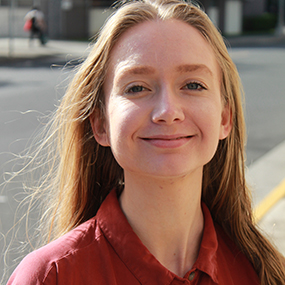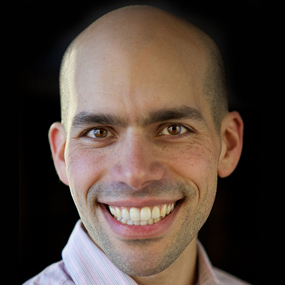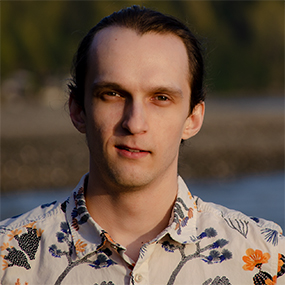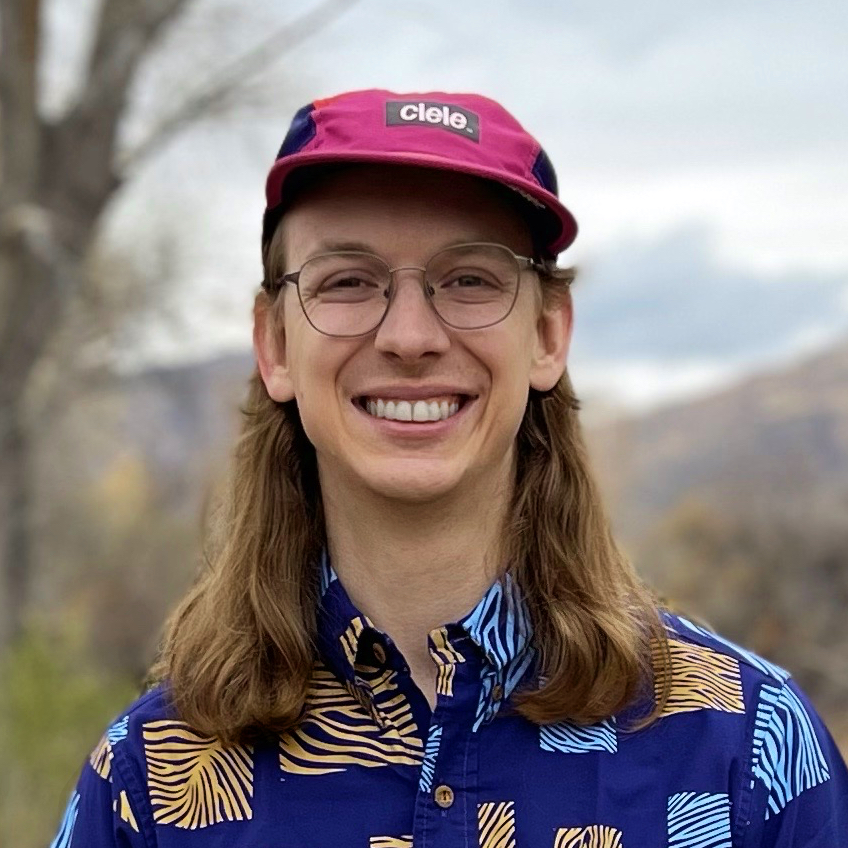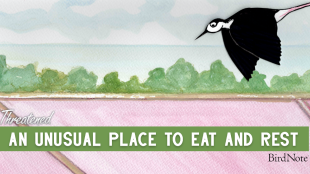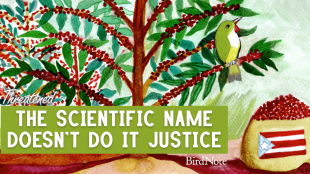

Join BirdNote tomorrow, November 30th!
Illustrator David Sibley and actor H. Jon Benjamin will face off in the bird illustration battle of the century during BirdNote's Year-end Celebration and Auction!
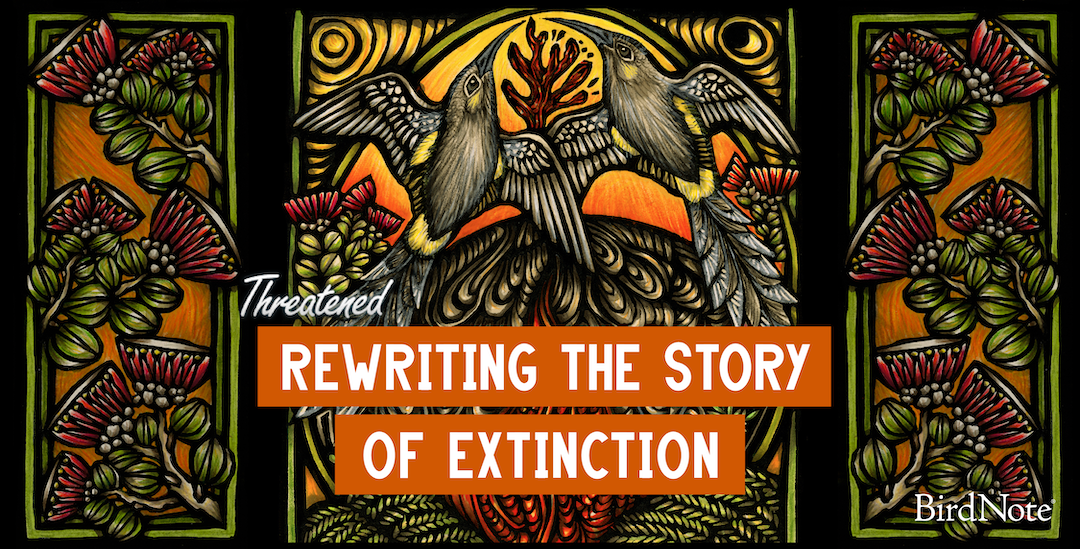
In 1823, a young princess was presented with an incredible gift, and a choice: protect the Native Hawaiian way of life, or embrace the teachings of newcomers. Today, the gift resides in a museum, and its story tells of tragedy and hope, the duality of life, and maybe a different understanding of our current extinction crisis.
Ari Daniel: BirdNote Presents.
[Echoing Wingflaps SFX]
[Reflective Threatened theme music begins]
Ari Daniel: This is Threatened and I’m your host, Ari Daniel. Our stories for this season so far have been told under the shadow… or reality… of extinction. In this episode, producer Savannah Harriman-Pote spent four months asking if there’s a story about extinction in Hawai‘i that has a not-so-dreadful ending. The story she found is about the largest piece of featherwork in Hawaiian history, the princess it was made for, and the birds whose feathers it was made from.
[Threatened Theme solo for a few seconds]
Savannah grew up in Hawai‘i and lives in Honolulu… but this story begins with her in Modesto, California… standing outside the wrong place.
Savannah Harriman-Pote (frantically talking to self): I’m at the wrong house! I’m at the wrong house!
[Threatened Theme ends]
[Footsteps as Savannah walks to find the right house]
Savannah Harriman-Pote: I’m in Modesto to see Rick San Nicolas, a master featherworker. I’m standing outside of what I thought was Rick’s house, only, after five minutes, to realize that I’m one street over, and I should have realized, because he has a giant Hawaiian flag outside of his door.
Rick San Nicolas: Well, hello there.
[Sound of front door creaking open]
Savannah Harriman-Pote: Hi! I went to the wrong house.
Rick San Nicolas: You did?
Savannah Harriman-Pote: You would have thought that the Hawaiian flag would have tipped me off.
[Both laughing]
Rick San Nicolas: How are you?
Savannah Harriman-Pote: I’m good, I’m good.
Rick San Nicolas: Nice to meet you!
Savannah Harriman-Pote: Rick is Native Hawaiian, or kanaka maoli. He was born in Honolulu in Hawai‘i and moved to California with his family when he was young.
Rick San Nicolas: Been here in California for quite a long time.
Savannah Harriman-Pote: But as soon as I step into his workshop…
Savannah Harriman-Pote: What an oasis!
[Hawaiian music can be heard gently in the background; somehow, the room sounds cozy]
Savannah Harriman-Pote: I feel like I’m back home in Hawai‘i. There’s Hawaiian music playing, he’s got koa wood furniture, and then just wall-to-wall feather capes.
Rick San Nicolas: It is the largest private collection in the world. And there’s probably, in the room, about, I think 26 or 28 feather capes.
Savannah Harriman-Pote: These capes, which are called ‘ahu ‘ula, are made from countless feathers, all tied to netting by hand. And the feathers range in color from iridescent greens to eye popping yellows and reds. And before I have a moment to take it in, Rick is ushering me over to this large set of drawers which contain, you guessed it, even more capes.
[Opening drawers, flipping through capes and items in his collection]
Rick San Nicolas: Most people don’t ever get to see this, but there’s, you know, there are drawers full of capes that are in here.
Savannah Harriman-Pote: One of my favorites that Rick shows me is a shoulder cape made from rooster feathers.
[Intrigue marimba music begins]
Savannah Harriman-Pote: It starts off with these beautiful rust colored feathers speckled with white, and then is bordered with these long feathers that are so dark they look like they’ve been dipped in ink. And that’s just one of the capes in Rick’s collection.
Ari Daniel: So Rick is a collector as well as a featherworker?
Savannah Harriman-Pote: Oh,Rick didn’t just collect these. Rick is a kumu hulu nui, or master featherworker. So he madeall of these capes. Featherworking is an artform that dates back centuries in Hawai‘i. ‘Ahu ‘ula like these capes were made for ali‘i, or chiefs. Now Rick has dedicated his life to the practice of featherworking, on recreating pieces of featherwork with historical significance. And he’s done a ton of these. But there was this one piece of art in particular that brought me to Modesto. I tracked Rick down because I heard that he wanted to recreate a special piece of featherwork: the pā‘ū of Nāhiʻenaʻena.
[Intrigue music solo, then ends]
Ari Daniel: Savannah… what’s a pā‘ū?
Savannah Harriman-Pote: So unlike almost everything else in Rick’s workshop, it’s not a cape, it’s not a cloak. It’s a skirt. And it was made for a princess.
[Sounds of a Maui beach; wind rushing past, waves crashing on the shore (Quiet Planet 2054)]
Savannah Harriman-Pote: Alright, so we’re going to leave Modesto, and jump back in time almost 200 hundred years to 1823.
[More sounds of Maui beach (Quiet Planet 2054) with birds in the distance (Quiet Planet 2079) Soundscape slowly fades out]
Savannah Harriman-Pote: We’re in the Kingdom of Hawai‘i. Specifically, we’re in Lahaina on Maui Island. It’s the seat of power for the royal family, led by Liholiho, who is also known as King Kamehameha II. Just a heads up, there will be more than one Kamehameha.
Ari Daniel: Ok,got it.
Savannah Harriman-Pote: The people of Lahaina get together to make a singular piece of art, something that has never been made before. A pā‘ū, or skirt, for the princess of the Kingdom and Liholiho’s sister, Harrieta Keōpūolani Nāhiʻenaʻena. It’s going to be the largest piece of featherwork in the history of Hawai‘i.
Ari Daniel: How big are we actually talking?
Savannah Harriman-Pote: It’s 20 feet long.
Ari Daniel: Wow!
Savannah Harriman-Pote: Yeah, just for scale. I’m five feet tall, so the pā‘ū is four times my size. I think it’s also like the height of two pro-league basketball hoops stacked on top of each other. And everything was made by hand… just like Rick is still doing today in his workshop in Modesto. So Rick shows me a little bit of his process while he makes a cloak. First, he takes a net in the final shape of the cloak— he has these custom made, and the one Rick shows me is about as big as a full-sized mattress, which doesn’t seem too large. But then, I see the feather bundles that Rick makes to tie onto the net…and they’re tiny.
Rick San Nicolas:There are three feathers in each bundle
Savannah Harriman-Pote:These feathers… I mean, one bundle is no bigger than a quarter, you’re not really doing yourself any favors.
Rick San Nicolas:[laughs] True. Very true.
Savannah Harriman-Pote: So really, to make a cloak, all Rick has to do is tie a bundle of feathers together and attach it to the netting…and he does that about 65,000 times.
Rick San Nicolas: So if you look at it at the finish form, it'll be well over 200,000 individual feathers and maybe closer to a quarter million individual feathers that'll be on, on a piece like this, too.
Ari Daniel: I could never do that! I have a cross-stitch that's taking me years to complete!
Savannah Harriman-Pote: Right? I don’t think I’ve ever done anything 65,000 times! So naturally, certain pieces of featherwork can take generations to make. But the people of Lahaina, they finished the pā‘ū in record time – only about eight months. Rick says that to complete it so quickly, master feather workers in Lahaina would have had to work around the clock, tying feather bundle after feather bundle after feather bundle after feather bundle…
Ari Daniel: Yeah, I get the idea. It seems like a tremendous undertaking, even for a princess.
Savannah Harriman-Pote: Well, Nāhiʻenaʻena isn’t just any princess. In Hawaii, your lineage determines the amount of mana, or power that you have. Nāhiʻenaʻena and her brother, Prince (cow-wee-kay-ow-oo-lee) Kauikeaouli, are two of the most powerful ali‘i, or chiefs, in history according to their bloodlines. They outranked even their late father, King Kamehameha I, often called King Kamehameha the Great.
Marques Hanalei Marzan: The story goes that Nāhiʻenaʻena and her siblings were carried upon the shoulders of King Kamehameha because he had to prostrate himself in recognition of their station and rank.
Savannah Harriman-Pote:Marques Hanalei Marzan is the Cultural Advisor to the Bishop Museum in Honolulu. The pā‘ū will end up in the Bishop Museum’s collection, along with many other national treasures from the Kingdom. So, Nāhiʻenaʻena is definitely deserving of this honor, based on rank alone. But Marques says it’s not just a matter of status. Nāhiʻenaʻena and her brother (cow-wee-kay-ow-oo-lee) Kauikeaouli represent the hope of the Kingdom of Hawai‘i. And for the people of Lahaina, it’s kind of a last hope.
Ari Daniel: How so, exactly?
Savannah Harriman-Pote: In the 1820s, the Kingdom of Hawai‘i is undergoing profound changes, due in large part to the presence of Christian missionaries, and all of the principles and, well, prejudice they brought with them. And this conflict is apparent in princess Nāhiʻenaʻena’s own life, basically from the beginning.
Marques Hanalei Marzan: So she's a young child, when missionaries come into Hawaii, you know, in the 1820s…but before that she was always being groomed and trained to be that next ruler, or that next level of the family line to pass on the legacy of the Kamehameha kuleana, or responsibilities to the next generation.
Savannah Harriman-Pote: So on one hand, she has to shoulder the expectations of the missionaries, as well as many in the Kingdom who were adopting this new set of values. Nāhiʻenaʻena’s own mother, an incredibly powerful ali‘i, converted to Christianity in 1823.
Ari Daniel: Isn’t that the same year the pā‘ū was made?
Savannah Harriman-Pote: Yes! And the feather workers who made the pā‘ū want Nāhiʻenaʻena to protect their way of life in Hawai‘i. And part of that is the hope that Nāhiʻenaʻena will ensure the royal line and the power of the ali‘i by bearing an heir…with (cow-wee-kay-ow-oo-lee) Kauikeaouli, her brother.
Ari Daniel: Oh wow, that’s um…that’s quite the responsibility.
Savannah Harriman-Pote: Yeah. That’s why they create a skirt rather than a cape. As a woman, Nāhiʻenaʻena is uniquely positioned to create and carry the future ruler of Hawai‘i. Only she has that reproductive power. And to be clear, the people of Lahaina anticipated that Nāhiʻenaʻena would wear the pā‘ū throughout her life. But in 1825, when it’s first presented to her…she’s only nine years old.
Marques Hanalei Marzan: At the age of nine, when the pā‘ū was completed and created and presented to her, she is battling this huge weight that's been put on her shoulders, the hopes and aspirations and dreams of her people for her and then her training for her missionary upbringing don't always come together very seamlessly. She had to navigate a very complex world and I can't imagine you know, a nine year old child today having to deal with that kind of weight.
Ari Daniel: That is a lot to carry for sure.
Savannah Harriman-Pote: Yeah, and also like – literally a lot to carry.
Ari Daniel: Right!
Savannah Harriman-Pote: So the pā‘ū is two and a half feet wide. At that age, it likely would have covered Nāhiʻenaʻena’s whole torso down to her feet, and it would have been wrapped around her several times. Here’s how Rick, the master featherworker, envisions it:
Rick San Nicolas: Only being nine years old, 20 feet long. I mean, you're going to be wrapped like a burrito.
Savannah Harriman-Pote: I mean, this is a heavy-duty garment. You might not expect that of featherwork, but Rick says that even just a cloak will take a toll after a while.
Rick San Nicolas: You know, I had a parrot, a macaw. And he was a miniature macaw. So even when I was making capes years ago, he would sit on my shoulder, you know, and the bird is probably all of a pound and a quarter. And, and just that weight from the bird sitting on my shoulder after about 20 minutes, I couldn't do it because you know, my shoulder was hurting.
Ari Daniel:So the weight of one of these cloaks is like having a couple dozen macaws sitting on your shoulders?
Savannah Harriman-Pote: Yes,exactly!
[Jazzy vibraphone, maraca, and brass music begins]
Rick San Nicolas: Light as a feather goes out the window, when it gets into the hundreds of 1000s that are on the body of a feather cloak.
Ari Daniel: So if something like a cloak can have hundreds of thousands of feathers, What about the pā‘ū? How many feathers does it have?
Savannah Harriman-Pote: Roughly the same number as the median home price on the island of O‘ahu, for those listening at home in the islands…yeah, we’re talking about at least a million feathers.
Ari Daniel: Wow, I wonder how many birds that factors out to be…
Savannah Harriman-Pote: Well, ok here’s the thing. The pā‘ū is almost entirely yellow. And all of those yellow feathers came from one species of bird - the ōʻō. It’s… Actually, let me show you a picture, an illustration really, of this bird.
Ari Daniel: Oh...That's different, I was expecting a fully yellow bird. But it’s not, it’s like a black bird, with kind of yellow adornments on its wings, and near the base of the body where the tail comes out.
Savannah Harriman-Pote: Right!The ōʻō’s plumage is largely black. Yellow pā‘ū, black bird. So in order to collect a million yellow feathers for all twenty feet of the pā‘ū, Marquez says you’d need at least 150,000 birds.
[Jazzy music abruptly ends, with the final note reverberating deeply]
Ari Daniel: Okay Savannah, slow down. How would you even collect that many feathers? Did they have to kill all those birds?
Savannah Harriman-Pote: By all accounts, no. Feathers were like the jewels of Hawaii, but their significance was more than just decorative. Rick says kanaka maoli believed that birds occupied a higher realm.
Rick San Nicolas: The Hawaiians felt that all the native Hawaiian birds were the most sacred, the feathers were the most sacred because they would be able to be the closest to heaven.
Savannah Harriman-Pote: And the feathers could capture just a little bit of that special power. That’s why they were reserved for the ali‘i. So birdcatchers would use poles with a sticky paste at its tip. And when a bird landed on the pole and got stuck, the birdcatcher would take just the feathers that were going to be used for feather-working, and then release the bird. Certainly, this wasn’t objectively good for them. Birds can only lose so many of their feathers before it starts to impact their health.
Ari Daniel: But they’re not killing the bird intentionally.
Savannah Harriman-Pote: Right. But here’s another remarkable thing about the pā‘ū – Marques believes that all these feathers were collected at one time— all one million of them.
Marques Hanalei Marzan: What is recorded is that the people of Lahaina went and gathered the feathers on Maui itself as a symbol of their love and commitment to their chief. And, you know, historically, there are very few examples of sightings of the ʻōʻō on the island of Maui.
Ari Daniel: So to make the pā‘ū there would have had to be at least 150,000 of them on Maui at one time… But somehow we don’t have anyone saying that they saw this bird. How is that possible?
Savannah Harriman-Pote: Well, the bird is extinct.
Marques Hanalei Marzan: Technically, there are no examples of a specimen of the ‘ōʻō from Maui in any collection, or museum institution around the world, even here in Hawai‘i.
Savannah Harriman-Pote: Except, Marques says, for the pā‘ū itself.
Ari Daniel:So this pā‘ū is the only physical evidence that we have of the existence of an entire species?
Savannah Harriman-Pote: Well, it’s hard to truly know for sure. There’s a couple of factors at play here. Birds lived in Hawai‘i for millions of years without ever having to contend with human beings.
[Birdsong from the higher elevation on Maui (Quiet Planet 2086)]
Ari Daniel: Sounds like a nice life.
Savannah Harriman-Pote: Yeah.But when Polynesians first arrived, they brought with them predators and changes to the landscape, all of which had a devastating effect on the islands’ bird populations. And by the time Europeans stumbled upon the islands about a thousand years later, over seventy kinds of birds had already gone extinct.
Ari Daniel: Hmmmm.
Savannah Harriman-Pote: And those are just the birds we know about –- through subfossil records or other collected specimens. Even more birds, like the ʻōʻō on Maui, just exist as stories. They’re almost like…ghosts.
[Kauai‘i Ō‘ō call, with reverb making it sound even more ethereal]
Ari Daniel: But Marques says the pā‘ū is made with feathers from ʻōʻō on Maui?
Savannah Harriman-Pote: Yes, but, ok here’s where it gets complicated. There are three officially recognized species of ‘ō‘ō, and the ʻōʻō that lived on Maui may have been one of those species. Probably the Molokai ‘ōʻō also known as Bishop’s ‘ōʻō.
Ari Daniel: Okay, that seems pretty straightforward.
Savannah Harriman-Pote: Well, there’s one part of that theory that just doesn’t quite add up for Marques. Each species of ‘ōʻō had its own defining characteristics, right — that’s how we distinguish them. Now, when you look at the feathers used in the pā‘ū, they don’t match up with any of the specimen records we have for the other ‘ōʻō species. And Marques invited me to the Bishop Museum to see the pā‘ū firsthand.
[The pā‘ū rustles loudly as Marques gets it out of storage]
Marques Hanalei Marzan: And here we are.
Savannah Harriman-Pote: Now,at first glance, it’s like looking at the sun, but once your eyes adjust, you can start to pick out these small brown dots amid this sea of golden feathers.
Marques Hanalei Marzan: …And if you look closely at the surface, you’ll start to notice like, oh, it’s everywhere! The whole thing is covered in these little black marks all over.
Savannah Harriman-Pote: It’s almost like it has freckles.
Marques Hanalei Marzan: Yeah, yeah, it almost does.
Savannah Harriman-Pote: And to Marques, those tiny freckles are the last calling card of an entirely unique species.
Ari Daniel: Because now all of those birds are gone.
Savannah Harriman-Pote: They’re all gone. But Marques says that when they were alive, ‘ōʻō on Maui reigned over the forests.
Marques Hanalei Marzan: …If you've been up into the mountains, you know, that there's these profusion of bird calls from all the different species, you know, the ‘i‘iwi bird…
[‘I‘iwi call, recording from Patrick Hart’s Listening Observatory for Hawaiian Ecosystems Lab]
Marques Hanalei Marzan: The ‘amakihi…
[‘Amakihi call]
Marques Hanalei Marzan: The apapane…
[‘Apapane call]
Marques Hanalei Marzan: The calls of each of these birds are very distinct. But what was recorded in many accounts …when ‘ōʻō came into an area, the forest went silent.
Ari Daniel: Really,why?
Savannah Harriman-Pote: Because the other birds would leave in deference to the ‘ōʻō, this big magnificent black bird just fringed in yellow. So no other bird could sing while the ‘ōʻō was singing. That’s been recorded on other islands, so it stands to reason that’s what happened on Maui. And the ōʻō ruled over the avian kingdom with the strength that the people of Lahaina hoped that Nāhiʻenaʻena would possess.
Marques Hanalei Marzan: I think that's quite a powerful kind of metaphor as well, you know, that even amongst the bird world, the ‘ōʻō was considered in a sense, supreme, you know, all other birds would leave. They would create that space for the ‘ōʻō. It might have just been a very territorial bird, you know, and just kicked everybody out, it could have been that… but, you know, that idea that even within the, the bird world, the ‘ōʻō had that kind of station or that authority is so symbolic, especially when you when you assume that those feathers were the ones that were where we sought after…
[Jazzy, inquisitive banjo and bass music begins]
Ari Daniel: We’re going to take a quick break. When we return, we find out the fate of Princess Nāhiʻenaʻena, her pā‘ū, and her people.
[Jazzy music fades out]
[MIDROLL AD BREAK]
Savannah Harriman-Pote: So nine years old — Nāhiʻenaʻena gets this pā‘ū, which, in addition to being five times her size, is made with a million feathers from a royal bird, and crafted through the tireless efforts of artists who are worried that their sacred practices would die out as their Kingdom is colonized, and the message couldn’t be clearer: Nāhiʻenaʻena - save us.
Ari Daniel: Wow, I mean. What did she do?
Savannah Harriman-Pote:Nāhiʻenaʻena wore the pā‘ū. But she wore a Victorian black dress under it, essentially straddling the growing rift in her world. And she continued to be pulled in different directions for the rest of her life: her kuleana, or responsibility, to her people and her religious beliefs, her love for her brother and the expectations of the missionaries. And when Nāhiʻenaʻena grew up, as was much anticipated, she became pregnant.
Ari Daniel: So the pā‘ū worked essentially? I mean, Nāhiʻenaʻena fulfilled the wish of her people?
Savannah Harriman-Pote: Well… at this point, Nāhiʻenaʻena’s brother has assumed the throne and taken on the name Kamehameha III. And when Nāhiʻenaʻena‘s baby is born, it will be next in line to succeed him.. But then… the baby was stillborn. And Nāhiʻenaʻena herself died just a few months later.
Ari Daniel: Oh wow. How old was she?
Savannah Harriman-Pote: 21 years old. Doctors weren’t able to determine the exact cause of her death. But a few accounts attribute Nāhiʻenaʻena’s death to grief over the loss of her child. That’s what Marques believes.
Marques Hanalei Marzan: She had so many hopes and aspirations and dreams, just like her people, for this young baby. For it to pass away, I think that weight just was too much for her.
Savannah Harriman-Pote: When Nāhiʻenaʻena died, her brother Kamehameha III had her pā‘ū cut in half and resewn.
Ari Daniel: Why would he do that?
Savannah Harriman-Pote: Well, it had a new purpose. It was resewn so that it could lay over Nāhiʻenaʻena’s casket at her funeral.
Ari Daniel: Wow. So it’s like, you’ve got this pā‘ū, this incredible symbol of hope for the future of the Kingdom. And it literally transforms to become a symbol of tragedy.
Savannah Harriman-Pote: Yeah, and that legacy continued. In 1891, the pā‘ū was part of the funeral of David Kalakaua, the last king of Hawai‘i. Two years later, a coup backed by US troops overthrew Queen Liliʻuokalani, Kalakaua’s sister and the sovereign monarch. The US annexed Hawai‘i in 1898, and President William Mckinley appointed Sanford P. Dole, the son of a prominent missionary family, as the territorial governor. Just over 60 years later, Hawai‘i became a state.
Ari Daniel: Wow.
Savannah Harriman-Pote: Yeah, it’s very hard not to think of all that loss when you look at the paʻu. Especially when you consider the fate of the ʻōʻō species. And I donʻt mean just the extinction of the ʻōʻō on Maui, the one whose feathers were used to make the p’au.Sojust after the death of Princess Nāhiʻenaʻena, the Oahu ʻōʻō was documented for the last time. ʻŌʻō birds were last seen on Molokai over a hundred years ago. And last year, the Kauaʻi ʻōʻō, the last remaining ʻōʻō species, was formally declared extinct. It hadn’t been seen in over 30 years. This is one of only a handful of recordings in existence of the ‘ō‘ō’s song.
[Kauai ‘ō‘ō singing; It has a sweet, almost mournful song]
Ari Daniel: Savannah, stop it!
Savannah Harriman-Pote: I know! I know.
Ari Daniel: I mean first, there’s the loss of Nāhiʻenaʻena and her child, and with it that particular hope for the Kingdom of Hawai‘i. But then you have the ʻōʻō, and it’s like you have this whole other royal lineage that’s unique to Hawaii, and that dwindles down to just one individual, and then you lose that too.
Savannah Harriman-Pote: Yeah. Yeah. You know, there’s this phrase you’ll hear over and over again when you talk about the islands: Hawai‘i is called the extinction capital of the world. And it’s true. I mean, two thirds of our bird species have gone extinct since the first arrival of humans in Hawai‘i.That’s the story I was raised with, and honestly, as someone who reports on biodiversity in the islands, that’s the story I’ve learned to tell. And it’s where I thought I was going to have to leave you at the end of this story. But…
Then I read this poem called The Last Safe Habitat by Craig Santos Perez. He wrote it for his daughter shortly after she was born. And he was thinking about that last Kauaʻi ʻōʻō, and he wanted a better story, just really anything with a glimmer of hope. Here, I’ll let Craig read it to you…
[Sound of paper flapping]
Craig Santos Perez: I realize I should have printed the font bigger. [laugh]
[Droning, sorrowful music begins]
The Last Safe Habitat
For the Kauaiʻi ʻŌʻō, whose song was last heard in 1987
I don’t want our daughter to know
that Hawai‘i is the bird extinction capital
of the world. I don’t want her to walk
around the island feeling haunted
by tree roots buried under concrete.
I don’t want her to fear the invasive
predators who slither, pounce,
bite, swallow, disease, and multiply.
I don’t want her to see paintings
and photographs of birds she’ll never
witness in the wild. I don’t want her to
imagine their bones in dark museum
drawers. I don’t want her to hear
their voice recordings on the internet.
I don’t want her to memorize and recite
the names of 77 lost species and subspecies.
I don’t want her to draw a timeline
with the years each was “first collected”
and “last sighted.” I don’t want her to learn
about the Kauaʻi ʻŌʻō, who was observed
atop a flowering ‘Ōhiʻa tree, calling
for a mate, day after day, season after
season, because he didn’t know he was
the last of his kind––
until one day, he disappeared,
forever, into a nest of avian silence.
I don’t want our daughter to calculate
how many miles of fencing is needed
to protect the endangered birds
that remain. I don’t want her to realize
the most serious causes of extinction
can’t be fenced out. I want to convince her
that extinction is not the end. I want
to convince her that extinction is
just a migration to the last safe habitat
on earth. I want to convince her
that our winged relatives have arrived
safely to their destination: a wondrous
island with a climate we can never
change, and a rainforest fertile
with seeds and song.
“What is lost
when a species,
an evolutionary lineage,
a way of life,
passes from the world?
What does this loss mean
within the particular
multispecies community
in which it occurs:
a community of humans
and nonhumans,
of the living
and the dead?”
––Thom Van Dooren,
Flight Ways: Life and Loss
at the Edge
of Extinction
Ari Daniel: Ah, that’s exquisite.
[Droning music fades out]
Savannah Harriman-Pote: Craig says it kind of comes from that desperate feeling of loving something - someone - that you can’t always protect.
Craig Santos Perez: For me, as a new father, when I wrote this poem, I wanted my daughter to hold on to her sense of wonder and awe towards the biodiversity and beauty of the planet. You know, not wanting to break her heart in a way, which I think would have broke my heart, if I had to kind of tell her the situation of birds in Hawaii, which, you know, is an animal that she especially loves.
Ari Daniel: Yeah, I mean, that’s the tension it brought up for me too. We have two small kids, and it’s like, you know, at what point do you introduce reality? You know, the thing about extinction is, is when someone comes into the world after something is gone, it’s not part of their reality. What kind of world are we, as adults, as people who know what’s happening, are we trying to create or change for our kids?
Savannah Harriman-Pote: Craig is not looking forward to the day where he has to answer those questions. How do you explain something like the extinction crisis? How do you make that okay? I’m not okay with it. But Craig says that we have to talk about it. We have to tell these stories. Even when they’re hard , and even when they’re sad. Because stories will keep us from losing these birds all over again.
Craig Santos Perez: I don’t think we fully understand as human beings what extinction means. Stories are our memories in many ways. And through stories we can pass on knowledge and wisdom and custom and of course histories. And so, you know, stories about birds or other lost species help keep them alive in our imagination.
Ari Daniel: And the pā‘ū does it too, in a way, doesn’t it?
Savannah Harriman-Pote: Yeah, that’s exactly what Marques thinks, and that’s why he considers it an honor to be a steward of the pā‘ū, even if that comes with a lot of difficult conversations.
Marques Hanalei Marzan: Going back to Hawaiian tradition, duality is integral. There's no separation of hope and fear and desperation. They're one in the same. The pā‘ū really is that physical example of the entire continuum, the past, the present, as well into the future.
Savannah Harriman-Pote: For Marques, even a last chance at saving something is still a chance.
Ari Daniel: Right, just the fact that the pā‘ū was made in the first place, and that it still exists is kind of a testament to that hope.
Savannah Harriman-Pote: And properly cared for, the cultural curators at Bishop Museum think the pā‘ū could easily last for generations, and with it the story of Nāhiʻenaʻena and the story of the ʻōʻō.
Marques Hanalei Marzan: To have the physical manifestation of it safeguarded in the museum, along with living examples within the community, I think only strengthens that resilience of the story of Nāhiʻenaʻena.
Savannah Harriman-Pote: And when Rick makes his pā‘ū, he wants to make it with its original dimensions, so that Kanaka maoli can see and experience what the pā‘ū was like in its intended form.
Ari Daniel: Speaking of, when will Rick be done with his pā‘ū?
Savannah Harriman-Pote: It’s on the to-do list! He’s looking to get it started early next year, which will be the 200th anniversary of when the kumu hulu nui of Lahaina created their pā‘ū for Nāhiʻenaʻena. But it took them 8 months, at least, to make the first one, so granted it will take a little bit of time. And ultimately, he would like to work with Bishop Museum to have it displayed alongside the original pā‘ū of Nāhiʻenaʻena.
Marques Hanalei Marzan: Rick's intention to create a pā‘ū in honor of Nāhiʻenaʻena, I think just brings us back to the beginning, you know, the intentions of why it was created, and for what purpose and for whom it was made.
Ari Daniel: There’s that duality again.
Savannah Harriman-Pote: Exactly. You know, Craig’s daughter, who he wrote the poem for, is seven now, just a couple of years younger than Nāhiʻenaʻena was when the pā‘ū was made for her. And like Nāhiʻenaʻena, Craig’s daughter is also inheriting a world that’s undergoing tremendous change. If she gets a chance to see the pā‘ū side by side, the original and Rick’s recreation, I hope she sees something we can’t.
Ari Daniel: Like what?
Savannah Harriman-Pote: A better story, and maybe one day, a better ending.
[Reflective Threatened Theme Song begins]
Ari Daniel: A better story is what a lot of people have been trying to create for the Hawaiian Crow, or the ʻAlalā. This is a bird that’s teetering on the precipice of extinction, and wrestling with that gives us a glimpse into just how messy conservation can be.
Rachel Kingsley: You know, you have another threatened/endangered species eating an endangered species. So there's not much we could do…
Ari Daniel: That’s next week on Threatened.
This episode was produced by Savannah Harriman-Pote and me, Ari Daniel. It was edited by Caitlin Pierce of the Rough Cut Collective. Audio mix by Sam Johnson and Mark Bramhill. Fact-checking by Conor Gearin. Our theme song and original music were composed by Ian Coss, with additional music by Blue Dot Sessions. Threatened is a production of BirdNote and overseen by Content Director Allison Wilson. You can find a transcript of this show and additional resources, BirdNote’s other podcasts, and much more at BirdNote dot org. Thanks for listening. See you next time.
[Theme music ends]
######################
SFX:
Bird sounds provided by The Macaulay Library of Natural Sounds at the Cornell Lab of Ornithology, Ithaca, New York. ML6031 - Kauai‘i Ō‘ō recorded by Robert Shallenberger.
‘Apapane and ‘Amakihi recordings provided by Patrick Hart at the Listening Observatory for Hawaiian Ecosystems (LOHE) Lab from the University of Hawai‘i at Hilo.
MUSIC:
Threatened Theme by Ian Coss
“The Kishner Method”, “Greylock”, “Chrome and Wax”, and “Tolls Folly” by Blue Dot Sessions

